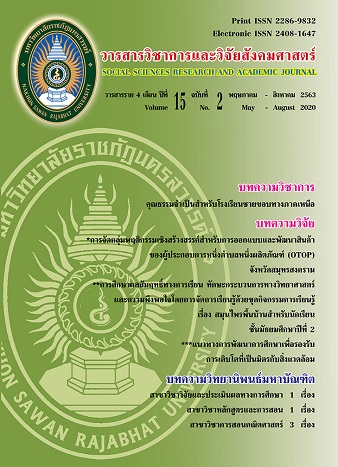การจัดกลุ่มพฤติกรรมเชิงสร้างสรรค์สำหรับการออกแบบและพัฒนาสินค้าของผู้ประกอบการหนึ่งตำบลหนึ่งผลิตภัณฑ์ (OTOP) จังหวัดสมุทรสงคราม Classification of Creative Behaviors for Product Design and Development Of One Tambon, One Product (OTOP) Entrepreneurs in Samutsongkhram Province
Main Article Content
Abstract
การวิจัยครั้งนี้มีวัตถุประสงค์เพื่อจัดกลุ่มพฤติกรรมเชิงสร้างสรรค์สำหรับการออกแบบและพัฒนาสินค้า โดยศึกษาจากกลุ่มตัวอย่างผู้ประกอบการหนึ่งตำบลหนึ่งผลิตภัณฑ์ (OTOP) จังหวัดสมุทรสงคราม ใช้แบบสอบถามเป็นเครื่องมือการวิจัย จำนวน 251 ชุด วิเคราะห์ข้อมูลด้วยค่าร้อยละ ความถี่ ค่าเฉลี่ย และส่วนเบี่ยงเบนมาตรฐาน และการวิเคราะห์กลุ่ม (Cluster Analysis) ใช้เทคนิคการวิเคราะห์กลุ่มแบบไม่เป็นขั้นตอน (Nonhierarchical Cluster) ตัวแปรที่ใช้ในการวิจัยนี้ประกอบด้วย 4 ตัวแปร ได้แก่ พฤติกรรมการแก้ไขปัญหา พฤติกรรมพร้อมที่จะเปลี่ยนแปลงความคิดและรับความคิดเห็นใหม่ พฤติกรรมกล้าคิดกล้าแสดงออก และพฤติกรรมชอบคิดหาคำตอบ
ผลการวิจัยพบว่าพฤติกรรมเชิงสร้างสรรค์สำหรับการออกแบบและพัฒนาสินค้าของผู้ประกอบการหนึ่งตำบลหนึ่งผลิตภัณฑ์ (OTOP) จังหวัดสมุทรสงคราม จัดกลุ่มได้เป็น 3 กลุ่ม มีลักษณะดังนี้ กลุ่มที่ 1 มีจำนวนสมาชิกจำนวน 145 คน คิดเป็นร้อยละ 57.7 เป็นกลุ่มที่มีความโดดเด่นด้านชอบคิดหาคำตอบ แสวงหาการทดลอง ต้องการค้นพบคำตอบด้วยตนเองและสามารถแก้ไขปัญหา นำความคิดมาปรับปรุงให้ดีขึ้น กลุ่มที่ 2 มีจำนวนสมาชิกจำนวน 90 คน คิดเป็นร้อยละ 35.86 เป็นกลุ่มที่มีความโดดเด่นด้านกล้าคิด กล้าแสดงออกชอบแสดงความคิดเห็นใหม่อยู่เสมอ และสามารถแก้ไขปัญหา นำความคิดมาปรับปรุงให้ดีขึ้น กลุ่มที่ 3 มีจำนวนสมาชิกจำนวน 16 คน คิดเป็นร้อยละ 6.37 เป็นกลุ่มที่ไม่มีความโดดเด่นด้านสามารถแก้ไขปัญหา นำความคิดมาปรับปรุงให้ดีขึ้น และด้านกล้าคิด กล้าแสดงออก ชอบแสดงความคิดเห็นใหม่อยู่เสมอ ทั้งนี้สามารถนำประโยชน์ของวิจัย รวมทั้งข้อเสนอแนะสำหรับงานวิจัยในอนาคตไปเป็นแนวทางในการพัฒนาตัวผู้ประกอบการ ในด้านความคิดสร้างสรรค์ต่อไป
The purpose of this research is to group creative behavior for product design and development. By studying a sample of OTOP entrepreneurs in Samut Songkhram province Questionnaires were used as a research tool in 251 sets. Data were analyzed using percentage, frequency, mean and standard deviation. And Cluster Analysis, using stepless group analysis techniques. (Nonhierarchical Cluster) The variables used in this research consist of 4 variables which are behavioral problem solving. Behavior is ready to change ideas and receive new ideas. Behavior brave, assertive And behavior like thinking of answers
The results showed that creative behavior for product design and development of OTOP entrepreneurs, Samut Songkhram province Can be grouped into 3 groups with the following characteristics: Group 1 has 145 members representing 57.7%, is a group that is outstanding in terms of thinking, answers, seeking experiments Want to find the answer by yourself And able to solve problems Group 2 has 90 members, representing 35.86 percent, which is a group that is outstanding in their ability to think, express themselves, and like to express new opinions. And able to solve problems Group 3 consisted of 16 members, representing 6.37%. The group was not outstanding in their ability to solve problems. Bring ideas to improve And the courage to think, act, and like to always express new opinions This can bring benefits of research. Including suggestions for future research as a guideline for development Entrepreneurs in the field of creativity
Article Details
References
กรมการพัฒนาชุมชน. (2562) .หนึ่งตำบลหนึ่งผลิตภัณฑ์. (5 มกราคม 2563) สืบค้นจากhttp://cep.cdd.go.th/services/otop2563
สมศักดิ์ ภู่วิภาดาวรรธน์. (2544). เทคนิคการส่งเสริมความคิดสร้างสรรค์. (พิมพ์ครั้งที่ 6). กรุงเทพฯ: ไทยวัฒนาพานิช.
ปราณี สุรสิทธิ์. (2549). การเขียนสร้างสรรค์เชิงวารสารศาสตร์ . กรุงเทพฯ: แสงดาว.
พูนเพิ่ม เสรีวิชยสวัสดิ์. (2561). Poonperm Serivichayaswad ภาควิชาบริหารธุรกิจ วิทยาลัยดุสิตธานี (Faculty of Hospitality Industry, Dusit Thani College) พฤติกรรมเชิงสร้างสรรค์ของบุคลากรที่มีความสำคัญต่ออุตสาหกรรมไมซ์ของประเทศไทย (Creative behavior of staff which is critical to Thailand’s MICE industry). 233-259.
ทรงศักดิ์ ภูสีอ่อน. (2561). การประยุกต์ใช้ SPSS วิเคราะห์ข้อมูลงานวิจัย. (พิมพ์ครั้งที่ 8). มหาสารคาม: ตักสิลาการพิมพ์.
กัลยา วานิชย์บัญชา. (2548). สถิติสำหรับงานวิจัย. กรุงเทพฯ: จุฬาลงกรณ์มหาวิทยาลัย.
สุคนธ์ทิพย์ มงคลเจริญ. (2555). อิทธิพลของรูปแบบความคิดสร้างสรรค์ การรับรู้ความสามารถของตนเอง และ ภาวะผู้นำการเปลี่ยนแปลงที่ส่งผลต่อพฤติกรรมการสร้างนวัตกรรมของพนักงานในงานธุรกิจสื่อไดเร็ค ทอรี่แห่งหนึ่ง. วิทยาศาสตรมหาบัณฑิต (จิตวิทยาอุตสาหกรรมและองค์การ). มหาวิทยาลัยรามคำแหง, กรุงเทพฯ.
ภุมรินทร์ ทวิชศรี. (2552). แรงจูงใจที่มีผลต่อการปฎิบัติงาน กรณีศึกษา บริษัท บางกอกกล๊าส จำกัด โรงงานจังหวัดปทุมธานี. ปทุมธานี: มหาวิทยาลัยราชมงคลธัญบุรี.
เฉลิมชัย กิตติศักดิ์นาวิน. (2554). ความสัมพันธ์ระหว่างความคิด สร้างสรรค์ของบุคคล เชาวน์อารมณ์ (EQ และเชาวน์ ทางจิต (SQ). หาดใหญ่วิชาการ, 9(1), 75-82.
สุดารัตน์ เหลาฉลาด. (2547). ความสัมพันธ์ระหว่างแรงจูงใจภายใน ภาวะผู้น าการเปลี่ยนแปลงของหัวหน้าหอผู้ป่วย สภาพแวดล้อมในงาน กับพฤติกรรมสร้างสรรค์ของพยาบาลวิชาชีพ โรงพยาบาลมหาวิทยาลัย ของรัฐ. วิทยานิพนธ์ปริญญามหาบัณฑิต (สาขาวิชาบริหารการพยาบาล). จุฬาลงกรณ์มหาวิทยาลัย, กรุงเทพฯ.
นัฐกานต์ ฐิติจำเริญพรและกัลยกิตติ์ กีรติอังกูร.(2561). ปัจจัยที่มีอิทธิพลต่อพฤติกรรมเชิงนวัตกรรมของพนักงานองค์การธุรกิจของ บริษัทโตโยต้า ไดฮัทสุ เอ็นจิเนียริ่ง แอนด์ แมนูแฟคเจอริ่ง จำกัด. Veridian E-journal, 11(2), 651-669.
Woodman, R.W., Sawyer, J.E., &Giffin, R.W.(1993). Toward a theory of organizational creativity. Academy of Management Review 18, 2: 293-321.
Guilford, J. P. (1967). The Nature of Human Intelligence. New York: McGraw – Hill.
________. (1988). Some Changes in the Structure – of – Intellect Model.Educational and Psychological Measurement. 48: 1 – 4.
Torrance, E.P. (1962). Guiding Creative talent. New Delhi: Prentice Hall.
Guilford, J.P. (1967). The Nature of Human Intelligence. New York: McGraw-Hill Book Co.
Kirton, M.J. (1994). Adaptors and innovators: styles of creativity and problem solving. Routledge, London.Yamane. (1967).
Likert, Rensis. (1961). New patterns of management. New York: McGraw-Hill Book Company, Nunnally, J.C. (1978). Psychometric theory. New York: McGraw-Hill.
Jaussi, K. S. & Dionne, S. D. (2003). Leading for creativity: The role of unconventional behavior. Journal of Leadership Quarterly, 14, 475-498.
Kanter, Rosabeth Moss. (1983). The change masters. New York: Simon and Schuster.
________. (1988). Three tiers for innovation research. Communication Research 15, 5: 509-523.


